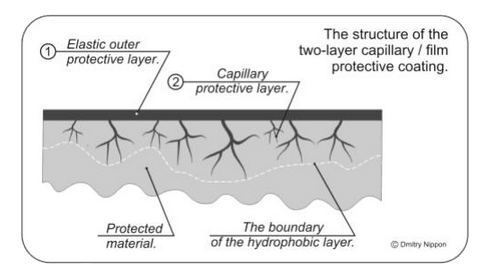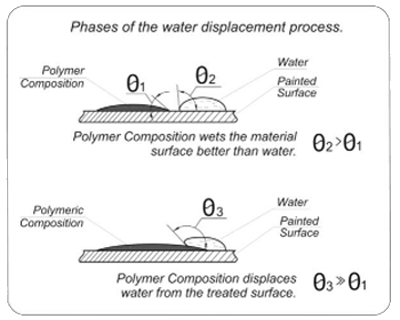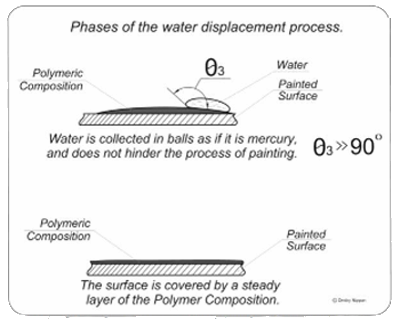Functions and Operating Principle of the Dewatering Polymer Compositions.
Traditional methods of a protective coatings applying on a various surfaces requires thorough cleaning of the base, priming and painting. The disadvantages of the classical technology are the high cost of the preparatory works, dependence on climatic conditions and cracking the films of paint and varnish materials. Under the influence of mechanical stress and thermal expansion / contraction of structures; a net of micro cracks quickly forms in a thickness of paint films that allows water to contact with the protected material. This leads to the development of under film corrosion spots (the so-called “beetles”), cracking and delamination of coatings and the loss of its protective properties. If the construction is subjected to considerable mechanical loads, vibrations or temperature changes the destruction of paint and varnish coverings occurs especially intensive.
The technology of Dewatering Polymers allows you to create materials without these disadvantages. Such materials possess a unique spectrum of properties, namely:
– High (1000% or more) extensibility of protective coatings eliminates the possibility of films cracking.
– The protective film is always a bit stretched that prevents it from local detachment, even if the material was applied to a poorly prepared surface.
– Dewatering Polymers are applicable both at dry and clean, as well as at wet and dirty surfaces and even under a water layer.
– High capillary permeability ensures high adhesion and creates an additional protective layer in the capillary structure of the protected material.
– The film-forming material has the ability to fill small damages of the coating that occurred during the exploitation (the so-called “Memory Effect”).
Let us repeat briefly.
Dewatering Polymer Chemistry Is:
a) High elasticity.
b) The absence of cracks.
c) The exception of delamination.
d) Application on a wet surface.
e) Work upon the old coatings and rust.
f) Filling of capillaries.
g) Memory effect.
h) History of creation and range of applications.
Multigrades Dewatering Polymer Compositions «Pokrol» are an improved modification of modern polymer-bitumen materials. These compositions have an improved microstructure and include several high-tech supplements and additives in their compounding. Dewatering Polymer materials are widely used for the protection of building materials and constructions against moisture and salt solutions, as well as for anticorrosion treatment of sea and river ships, vehicles and to protect bridges and mooring facilities.
Dewatering Polymer Compositions are applied equally well both on dry and clean or wet and dirty surfaces. For this reason, they are especially effective when used on large objects, exposed to constant moisture and salt fogs and in the cases where before treatment drying is difficult or impossible.
As it known, at the micro level bitumen-polymer materials are the mixture of oxidized bitumen and SBS (styrene-butadiene-styrene) rubber or an equivalent polymer, molecules of which looks like a thin threadlike structures. The main task of the synthesis of such materials is the necessity to deploy rubber molecules of tangles in the threads and to fix them in such condition. Conventionally, this problem is solved by mixing the heated components for some period of time.
The microstructure of the Polymer Compositions.
 Materials offered by our company obtained from the chemical reactor of new generation uses the other technology and physical principles. As a result of the use of non-standard synthesis technology, polymer molecules are not only fully unwound in thread but intertwined like fibers of a nonwoven textile. Such a microstructure provides more extensibility, frost resistance and water resistance of our materials in comparison with the best known analogues. To maintain the structure in the stable state, the material is dissolved in a in a mixture of specially selected solvents.
Materials offered by our company obtained from the chemical reactor of new generation uses the other technology and physical principles. As a result of the use of non-standard synthesis technology, polymer molecules are not only fully unwound in thread but intertwined like fibers of a nonwoven textile. Such a microstructure provides more extensibility, frost resistance and water resistance of our materials in comparison with the best known analogues. To maintain the structure in the stable state, the material is dissolved in a in a mixture of specially selected solvents.
Polymeric compositions are delivered to consumers in the form of a viscous colloidal solution. Application is performed using the cold process, which eliminates the damage of the microstructure when heating in bitumen boilers at a construction site.
Extremely high capillary permeability.


New structural formula of the materials suggested by our company provides a very high capillary permeability of Polymer Compositions. Polymers penetrate deeply into the pores and microcracks and create a waterproof flexible membrane on the treated surfaces.
Two weatherproof layers are formed: the internal which is an impregnated porous material and the external which is a hydrophobic elastic film. In case of a damage of the outer protective layer waterproofing properties of the coating do not reduce, because all the pores of the material of the internal layer are locked by the micro plugs formed by the solidified polymer.
High capillary permeability of the Compositions minimizes a rust cleaning process of the metal because the layer of a porous rust will be impregnated while treatment. So, corroded surface will not affect the adhesion of the coating.